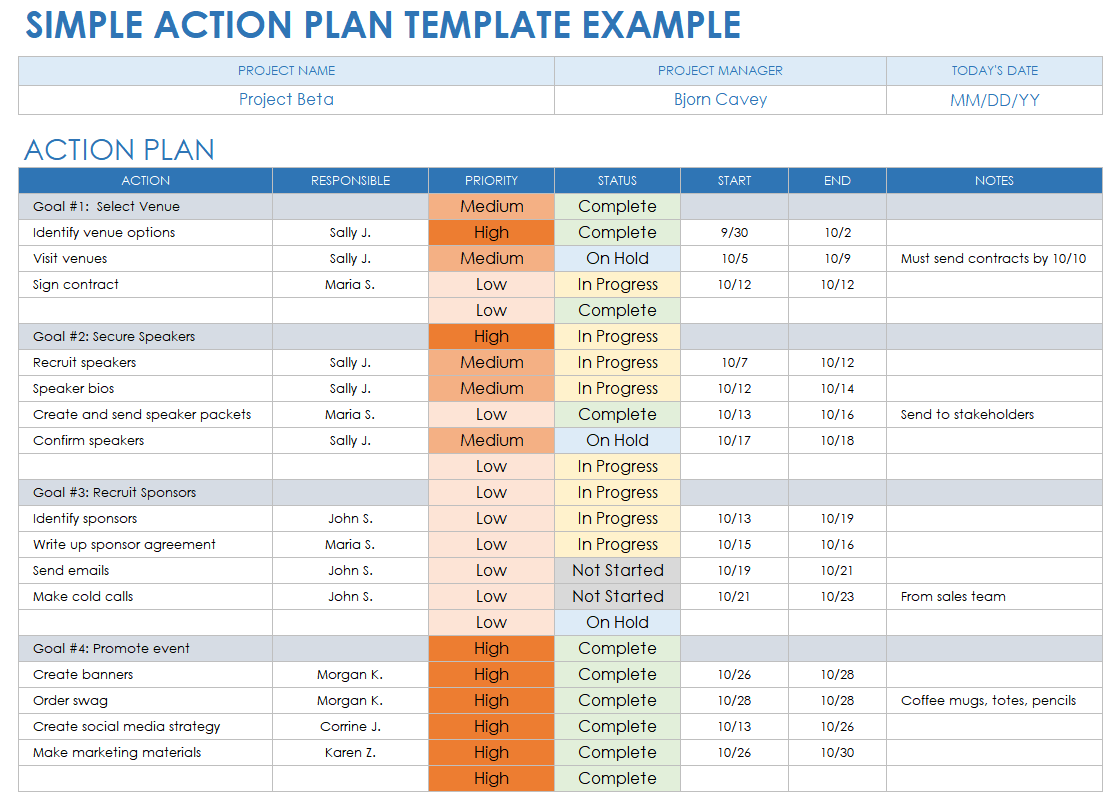An action plan is a roadmap that helps individuals, teams, or organizations achieve specific goals. It breaks down complex objectives into manageable tasks, providing a clear path forward. Whether you’re launching a project, implementing a strategy, or pursuing personal development goals, having a well-defined action plan is essential for success.
Why Do You Need an Action Plan?
An action plan serves several crucial purposes:
- Clarity: It clarifies the objectives and steps required to achieve them.
- Focus: It helps in staying focused on priorities and avoiding distractions.
- Accountability: It assigns responsibilities and holds individuals or teams accountable for their tasks.
- Efficiency: It maximizes efficiency by organizing tasks and resources effectively.
- Measurement: It provides a basis for measuring progress and making adjustments as needed.

Components of Action Plan:
Here are the effective components that are discussed below:
Goal Statement: Clearly define the goal or objective you want to achieve. Make sure it’s specific, measurable, achievable, relevant, and time-bound (SMART).
Action Steps: Break down the goal into actionable steps or tasks. Each action step should be clear, specific, and achievable within a reasonable timeframe.
Timeline: Establish a timeline for each action step, including start and end dates. This helps in setting deadlines and managing time effectively.
Responsibilities: Assign responsibilities for each action step. Clearly define who is responsible for what to ensure accountability.
Resources: Identify the resources required to accomplish each action step. This may include human resources, budget, equipment, or other assets.
Potential Obstacles and Solutions: Anticipate potential obstacles or challenges that may arise and develop strategies to overcome them.
Monitoring and Evaluation: Establish methods for monitoring progress and evaluating results. Regularly review the action plan to track progress and make necessary adjustments.
Communication Plan: Define how information will be communicated among team members. Establish channels for regular updates, meetings, and reporting.
Related Article: 9 Useful Tips To Create A Rolling Action Item List – PMITOOLS
Who Manages Action Plan:
The management of an action plan typically falls to the individual or team responsible for overseeing the project or initiative. This could be a project manager, team leader, department head, or even the person directly responsible for achieving the goal outlined in the action plan. The manager’s role involves several key tasks, including creating the action plan, assigning tasks to team members, monitoring progress, providing support and resources as needed, and ensuring that the plan stays on track. They are also responsible for resolving any issues or obstacles that arise during the execution of the plan and making adjustments as necessary to ensure successful completion of the project.
Related Article: 5 Useful Steps To Create Work Plan Template Excel – PMITOOLS
Why it is important?
Here are several key reasons why action plans are important:
Clarity and Direction:
- Focus: An action plan provides clear direction, helping individuals or teams stay focused on what needs to be done.
- Specificity: By breaking down goals into actionable steps, it clarifies exactly what needs to be accomplished.
- Prioritization: It helps in identifying and prioritizing tasks, ensuring that efforts are directed towards the most important activities.
Achieving Goals:
- Roadmap to Success: An action plan serves as a roadmap, guiding individuals or teams towards the achievement of their goals.
- Measurable Objectives: It sets measurable objectives, allowing progress to be tracked and evaluated effectively.
- Accountability: Assigning responsibilities in an action plan ensures accountability, motivating individuals to complete their tasks.
Efficiency and Productivity:
- Optimized Resource Allocation: By identifying required resources upfront, action plans ensure efficient allocation of time, money, and manpower.
- Time Management: Setting deadlines and timelines helps in managing time effectively, avoiding procrastination and ensuring timely completion of tasks.
- Eliminating Redundancy: Action plans help in identifying redundant or unnecessary tasks, streamlining processes for greater efficiency.
Team Collaboration and Communication:
- Clarifying Roles: Assigning responsibilities in an action plan clarifies individual roles and fosters teamwork.
- Communication: Action plans facilitate communication among team members by providing a shared understanding of objectives and tasks.
- Alignment: Ensures that everyone is aligned with the overall goals and objectives, reducing misunderstandings and conflicts. Measuring Progress and Success:
- Tracking Progress: Action plans provide a basis for tracking progress towards goals, allowing for regular monitoring and evaluation.
- Measuring Success: By defining clear objectives and milestones, action plans enable the measurement of success and the celebration of achievements.
- Learning and Improvement: Analyzing the effectiveness of action plans helps in identifying areas for improvement and learning from past experiences.
Related Article: 6 Steps For Creating Agile Project Plan Template | PMITOOLS.NET
What is Action Plan Template?
An action plan template is a structured document that outlines the steps, tasks, responsibilities, timelines, and resources required to achieve a specific goal or objective. It serves as a guide for organizing and executing tasks efficiently.
For Project Management Templates Visit: Project Management Documents Templates (ucube.biz)




